2017 MITSUBISHI iMiEV light
[x] Cancel search: lightPage 13 of 296
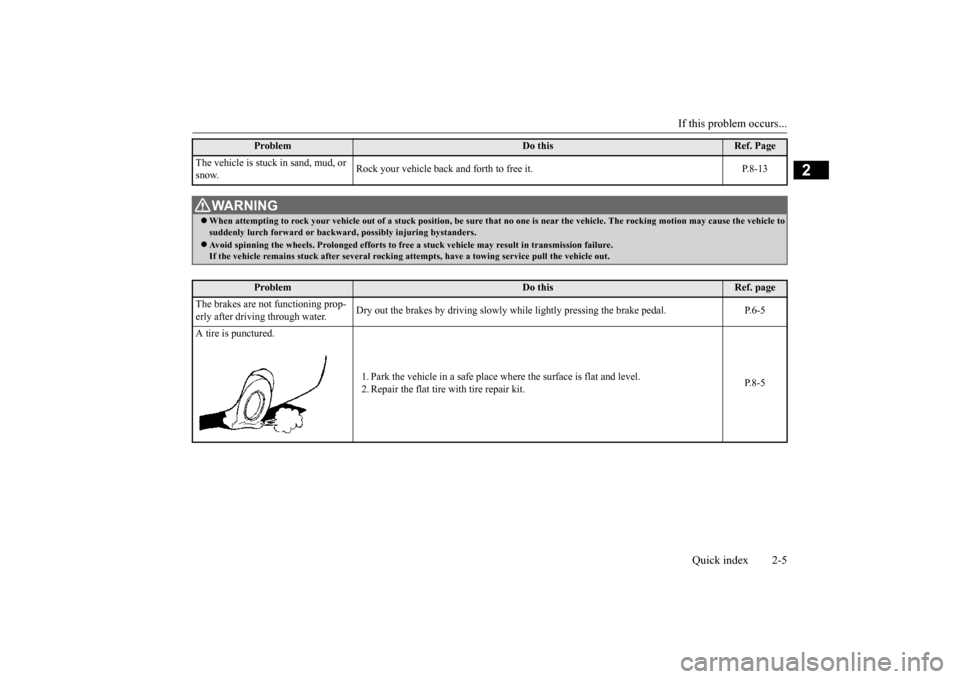
If this problem occurs...
Quick index 2-5
2
The vehicle is stuck
in sand, mud, or
snow.
Rock your vehicle back and forth to free it. P.8-13
WA R N I N G When attempting to rock your vehicle out of
a stuck position, be sure that
no one is near the vehicl
e. The rocking motion may c
ause the vehicle to
suddenly lurch forward or backward, possibly injuring bystanders. Avoid spinning the wheels. Prolonged efforts to free
a stuck vehicle may result
in transmission failure.
If the vehicle remains stuck after several rocking attempts, have a towing service pull the vehicle out.
Problem
Do this
Ref. page
The brakes are not functioning prop- erly after driving through water.
Dry out the brakes by driving slowly whil
e lightly pressing the brake pedal. P.6-5
A tire is punctured.
1. Park the vehicle in a safe place where the surface is flat and level. 2. Repair the flat tire with tire repair kit.
P.8-5
Problem
Do this
Ref. Page
BK0220401US.book 5 ページ 2015年6月3日 水曜日 午前7時42分
Page 16 of 296
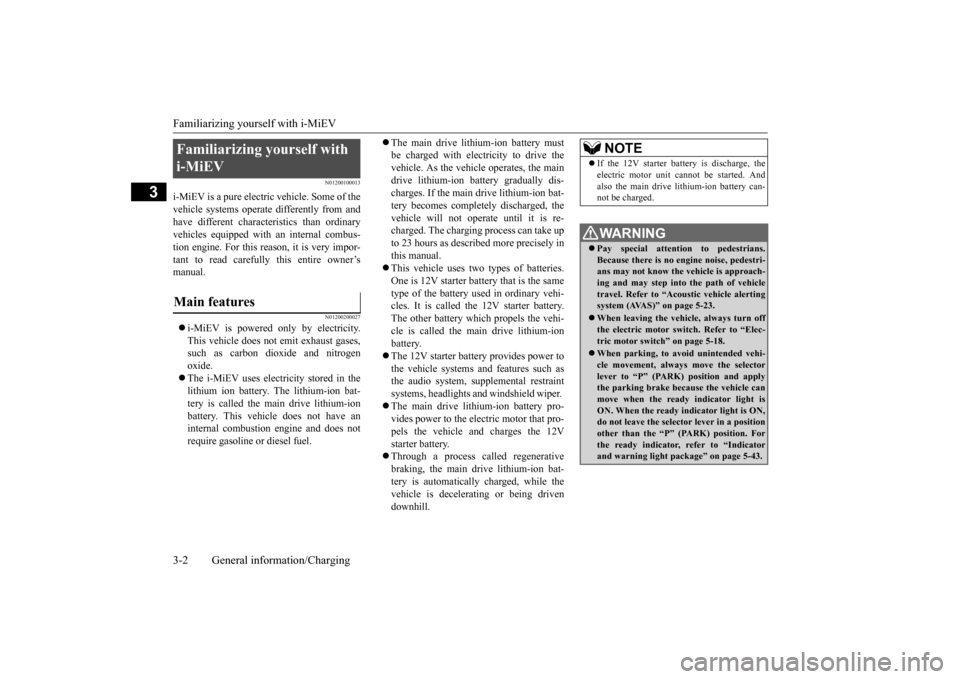
Familiarizing yourself with i-MiEV 3-2 General information/Charging
3
N01200100013
i-MiEV is a pure electric vehicle. Some of the vehicle systems operate differently from and have different characteristics than ordinaryvehicles equipped with an internal combus- tion engine. For this reas
on, it is very impor-
tant to read carefull
y this entire owner’s
manual.
N01200200027
i-MiEV is powered only by electricity. This vehicle does not
emit exhaust gases,
such as carbon dioxide and nitrogenoxide. The i-MiEV uses electricity stored in the lithium ion battery. The lithium-ion bat-tery is called the main drive lithium-ion battery. This vehicl
e does not have an
internal combustion engine and does notrequire gasoline
or diesel fuel.
The main drive lithium-ion battery must be charged with electricity to drive thevehicle. As the vehi
cle operates, the main
drive lithium-ion battery gradually dis- charges. If the main drive lithium-ion bat-tery becomes completely discharged, the vehicle will not
operate until it is re-
charged. The charging process can take upto 23 hours as descri
bed more precisely in
this manual. This vehicle uses two types of batteries. One is 12V starter battery that is the same type of the battery used in ordinary vehi-cles. It is called the 12V starter battery. The other battery which propels the vehi- cle is called the main drive lithium-ionbattery. The 12V starter battery provides power to the vehicle systems and features such asthe audio system, supplemental restraint systems, headlights a
nd windshield wiper.
The main drive lithium-ion battery pro- vides power to the electric motor that pro- pels the vehicle and charges the 12V starter battery. Through a process called regenerative braking, the main drive lithium-ion bat- tery is automatically charged, while thevehicle is decelera
ting or being driven
downhill.
Familiarizing yourself with i-MiEV Main features
NOTE
If the 12V starter batter
y is discharge, the
electric motor unit ca
nnot be started. And
also the main drive lithium-ion battery can-not be charged.WA R N I N G Pay special attention to pedestrians. Because there is no engine noise, pedestri- ans may not know the vehicle is approach-ing and may step into
the path of vehicle
travel. Refer to “Aco
ustic vehicle alerting
system (AVAS)
Page 17 of 296
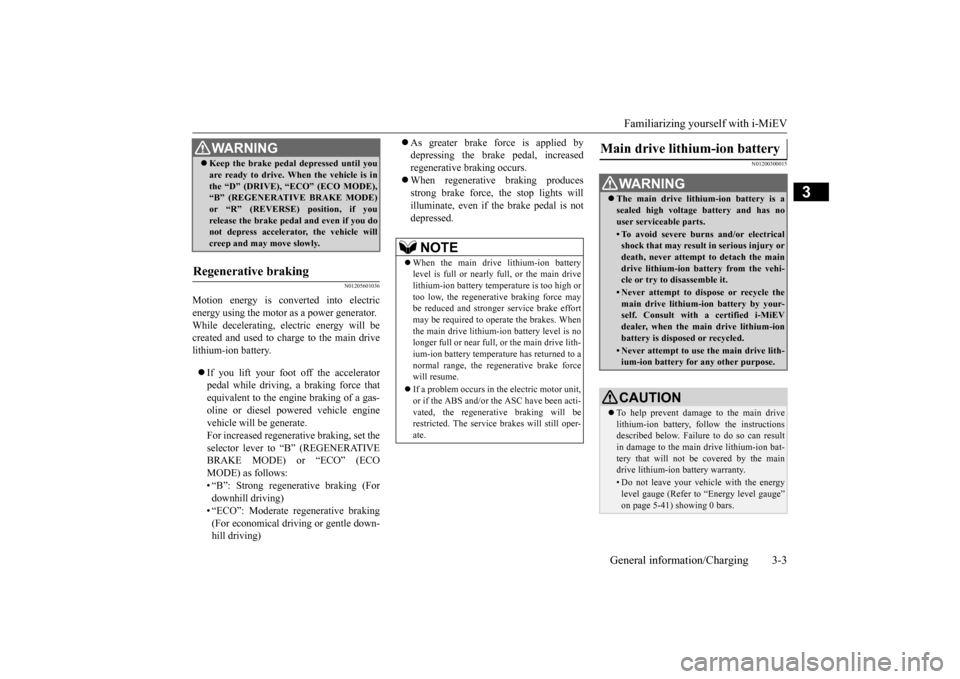
Familiarizing yourself with i-MiEV
General information/Charging 3-3
3
N01205601036
Motion energy is converted into electric energy using the motor as a power generator. While decelerating, electric energy will becreated and used to charge to the main drive lithium-ion battery. If you lift your foot off the accelerator pedal while driving, a braking force thatequivalent to the engine braking of a gas- oline or diesel powered vehicle engine vehicle will
be generate.
For increased regenerative braking, set the selector lever to “B” (REGENERATIVE BRAKE MODE) or “ECO” (ECOMODE) as follows: • “B”: Strong regenerative braking (For downhill driving)• “ECO”: Moderate regenerative braking (For economical driving or gentle down- hill driving)
As greater brake fo
rce is applied by
depressing the brak
e pedal, increased
regenerative braking occurs. When regenerative braking produces strong brake force, the stop lights willilluminate, even if the brake pedal is not depressed.
N01200300015
Keep the brake pedal depressed until you are ready to drive. When the vehicle is inthe “D” (DRIVE), “ECO” (ECO MODE),“B” (REGENERATIVE BRAKE MODE) or
Page 19 of 296
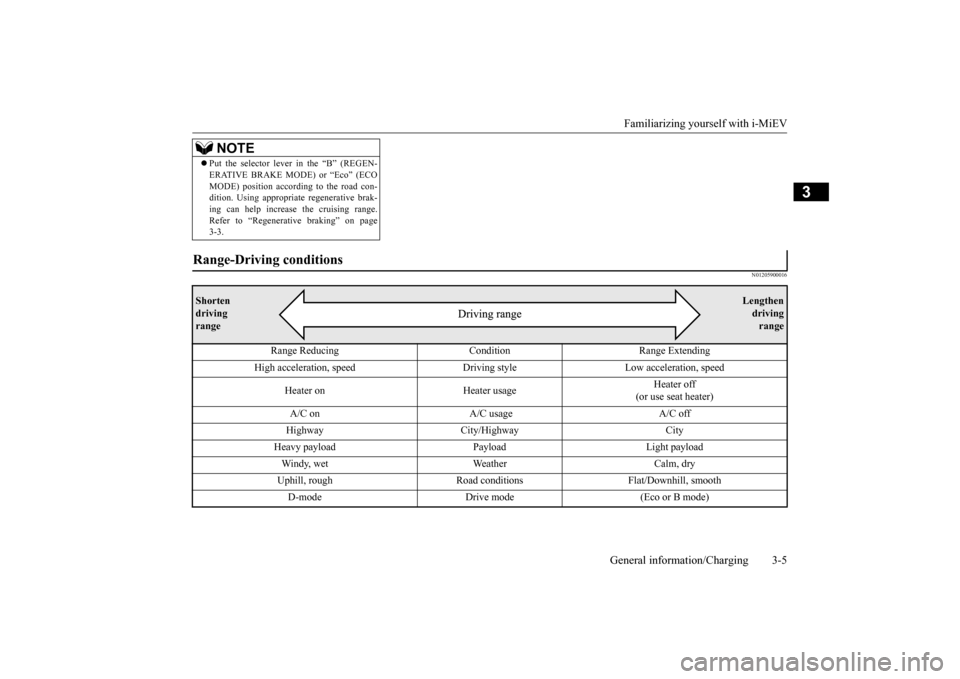
Familiarizing yourself with i-MiEV
General information/Charging 3-5
3
N01205900016
Put the selector lever in the “B” (REGEN- ERATIVE BRAKE MODE) or “Eco” (ECOMODE) position according to the road con-dition. Using appropriate regenerative brak- ing can help increase
the cruising range.
Refer to “Regenerative braking” on page3-3.NOTE
Range-Driving conditions Shorten driving range
Lengthen
driving range
Range Reducing Condition Range Extending
High acceleration, speed Driving
style Low acceleration, speed
Heater on Heater usage
Heater off
(or use seat heater)
A/C on A/C usage A/C off Highway City/Highway City
Heavy payload Payload Light payload Windy, wet Weather Calm, dry Uphill, rough Road conditio
ns Flat/Downhill, smooth
D-mode Drive mode (Eco or B mode)
BK0220401US.book 5 ページ 2015年6月3日 水曜日 午前7時42分
Page 23 of 296
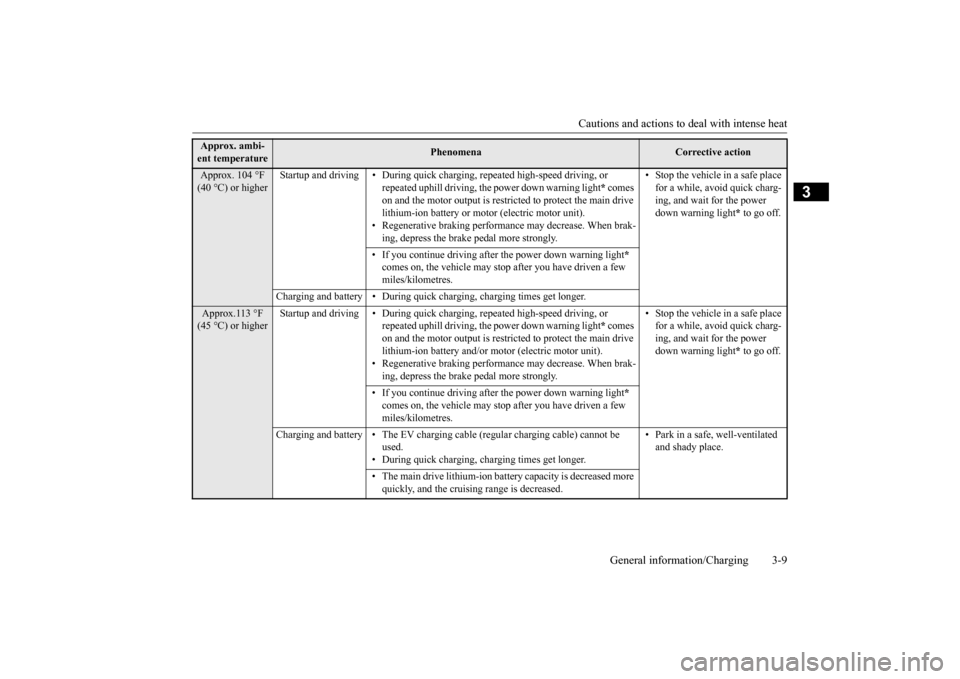
Cautions and actions to deal with intense heat
General information/Charging 3-9
3
Approx. ambi- ent temperature
Phenomena
Corrective action
Approx. 104 °F (40 °C) or higher
Startup and driving •
ed high-speed driving, or
repeated uphill driving, th
e power down warning light
* comes
on and the motor output is restricted to protect the main drive lithium-ion battery or motor (electric motor unit).Regenerative braking performa
nce may decrease. When brak-
ing, depress the brak
e pedal more strongly.
• Stop the vehicle in a safe place for a while, avoid quick charg- ing, and wait for the power down warning light
* to go off.
• If you continue driving afte
r the power down warning light
*
comes on, the vehicl
e may stop after you have driven a few
miles/kilometres.
Charging and battery • During quick ch
arging, charging times get longer.
Approx.113 °F (45 °C) or higher
Startup and driving •
ed high-speed driving, or
repeated uphill driving, th
e power down warning light
* comes
on and the motor output is restricted to protect the main drive lithium-ion battery and/or motor (electric motor unit). Regenerative braking performa
nce may decrease. When brak-
ing, depress the brak
e pedal more strongly.
• Stop the vehicle in a safe place for a while, avoid quick charg-ing, and wait for the power down warning light
* to go off.
• If you continue driving afte
r the power down warning light
*
comes on, the vehicl
e may stop after you have driven a few
miles/kilometres.
Charging and battery •
charging cable) cannot be
used. During quick charging, charging times get longer.
• Park in a safe, well-ventilated and shady place.
• The main drive lithium-ion batte
ry capacity is decreased more
quickly, and the cruisi
ng range is decreased.
BK0220401US.book 9 ページ 2015年6月3日 水曜日 午前7時42分
Page 24 of 296
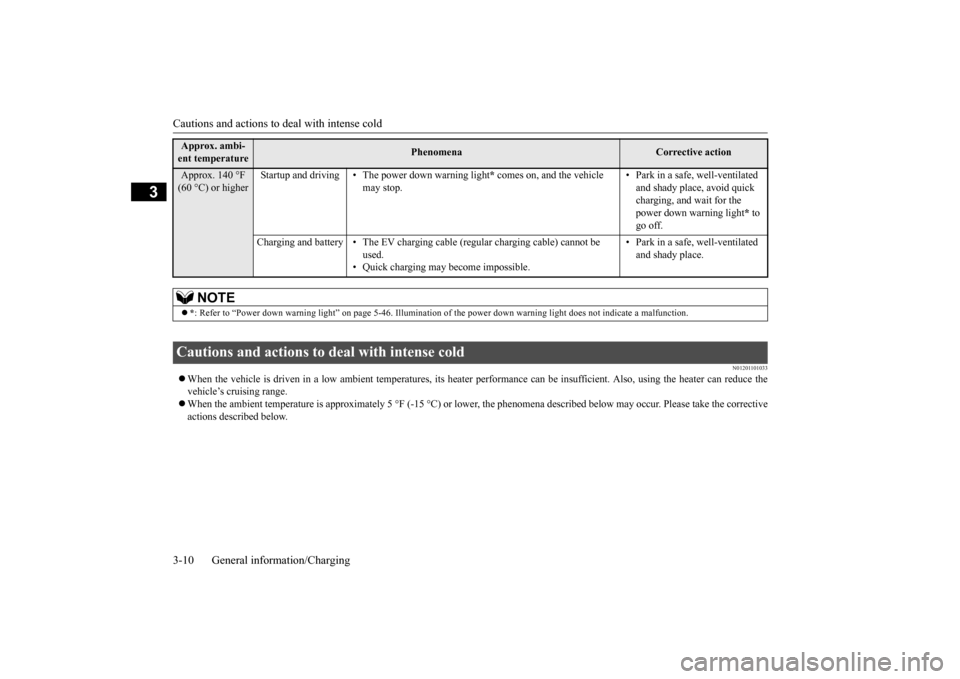
Cautions and actions to deal with intense cold 3-10 General information/Charging
3
N01201101033
When the vehicle is driven in a low ambient temperatures, its he
ater performance can be insuffic
ient. Also, using the heater ca
n reduce the
vehicle’s cruising range. When the ambient temperature is approximately 5 °F (-15 °C) or
lower, the phenomena de
scribed below may occu
r. Please take the
corrective
actions described below.Approx. 140 °F (60 °C) or higher
Startup and driving • The power down warning light
* comes on, and the vehicle
may stop.
• Park in a safe, well-ventilated and shady place, avoid quick charging, and wait for the power down warning light
* to
go off.
Charging and battery •
used.Quick charging may become impossible.
• Park in a safe, well-ventilated and shady place.
NOTE
*: Refer to “Power down warning light” on pa
ge 5-46. Illumination of the power down wa
rning light does not i
ndicate a malfunctio
n.
Cautions and actions to deal with intense cold Approx. ambi- ent temperature
Phenomena
Corrective action
BK0220401US.book 10 ページ 2015年6月3日 水曜日 午前7時42分
Page 25 of 296
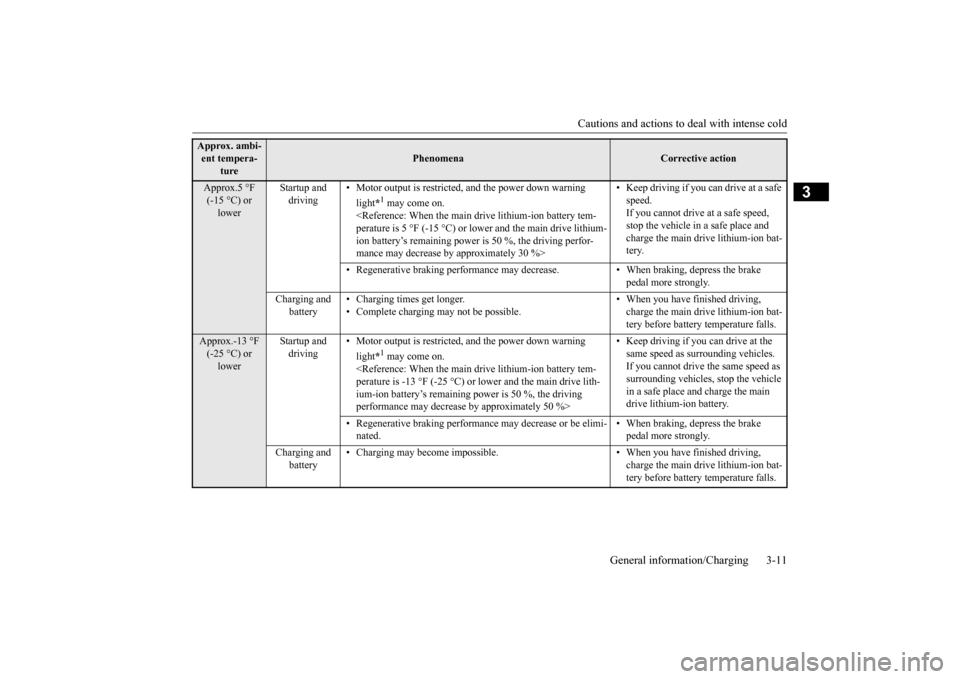
Cautions and actions to deal with intense cold
General information/Charging 3-11
3
Approx. ambi- ent tempera-
ture
Phenomena
Corrective action
Approx.5 °F (-15 °C) or lower
Startup and driving
• Motor output is restricted
, and the power down warning
light
*1 may come on.
• Keep driving if you can drive at a safe speed. If you cannot drive at a safe speed, stop the vehicle in
a safe place and
charge the main drive lithium-ion bat- tery.
• Regenerative braking performance may decr
ease. • When braking, depress the brake
pedal more strongly.
Charging and
battery
• • Charging times get longer. Complete charging may not be possible.
• When you have finished driving, charge the main drive lithium-ion bat- tery before battery temperature falls.
Approx.-13 °F (-25 °C) or lower
Startup and driving
• Motor output is restricted
, and the power down warning
light
*1 may come on.
ium-ion battery’s remaining power is 50 %, the driving performance may decrease by approximately 50 %>
• Keep driving if you can drive at the same speed as su
rrounding vehicles.
If you cannot drive the same speed as surrounding vehicles, stop the vehicle in a safe place and charge the main drive lithium-ion battery.
• Regenerative braking performan
ce may decrease or be elimi-
nated.
• When braking, depress the brake pedal more strongly.
Charging and
battery
• Charging may become impossible. • W
hen you have finished driving, charge the main drive lithium-ion bat- tery before battery temperature falls.
BK0220401US.book 11 ページ 2015年6月3日 水曜日 午前7時42分
Page 26 of 296
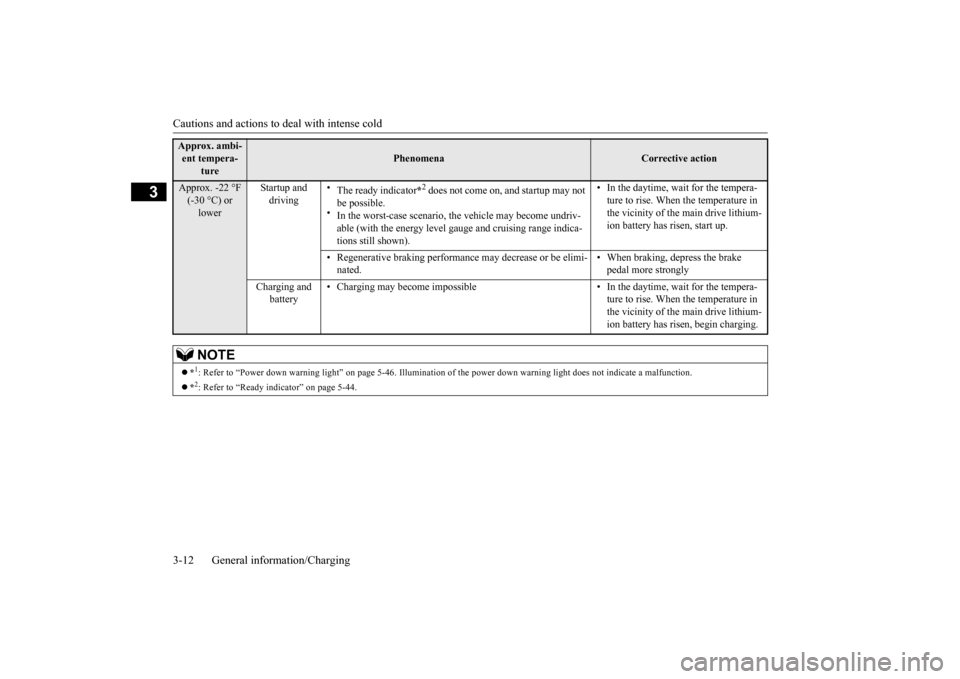
Cautions and actions to deal with intense cold 3-12 General information/Charging
3
Approx. -22 °F (-30 °C) or lower
Startup and driving
• • The ready indicator
*2 does not come on, and startup may not
be possible. In the worst-case scenario,
the vehicle may become undriv-
able (with the energy level ga
uge and cruising range indica-
tions still shown).
• In the daytime, wait for the tempera- ture to rise. When the temperature in the vicinity of the main drive lithium-ion battery has risen, start up.
• Regenerative braking performance
may decrease or be elimi-
nated.
• When braking, depress the brake pedal more strongly
Charging and
battery
• Charging may become impossible • In the daytime, wait for the tempera-
ture to rise. When the temperature in the vicinity of the main drive lithium- ion battery has rise
n, begin charging.
NOTE
*1: Refer to “Power down warning light” on pa
ge 5-46. Illumination of th
e power down warning light doe
s not indicate a malfunctio
n.
*2: Refer to “Ready indicator” on page 5-44.
Approx. ambi- ent tempera-
ture
Phenomena
Corrective action
BK0220401US.book 12 ページ 2015年6月3日 水曜日 午前7時42分